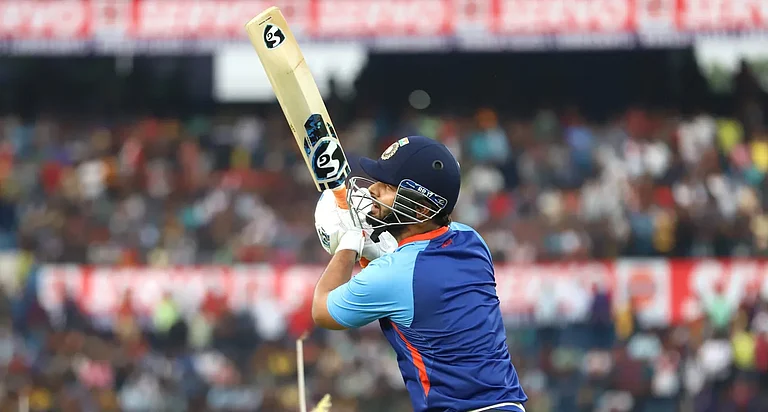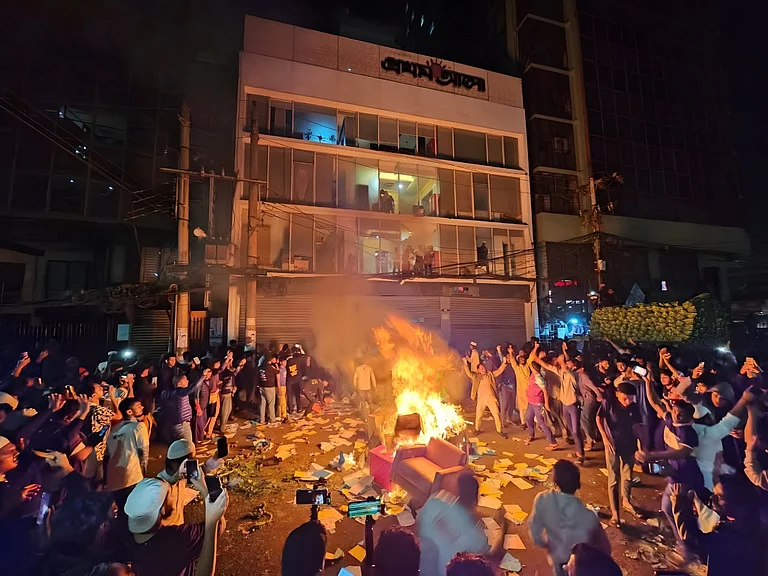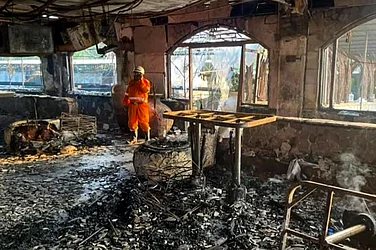Before he was born in Basaguda village of Bijapur district of Bastar, the wilderness had become the headquarters of Maoist insurgency. Having lost his father early, he was in his teens when his village was uprooted when the State-funded anti-Maoist militia Salwa Judum was active in 2005-2007. His mother, an anganwadi worker, sent him to a government hostel and shifted to Basaguda refugee camp, some 30 km from their village, before she was again forced to shift to another refugee camp in Avapalli. She died of cancer nine years ago.
With such sorrows behind him, Mukesh Chandrakar struggled as a freelance journalist for a decade, before he launched his YouTube channel Bastar Junction last May. In less than a year, the venture has brought him sufficient money as well as given him enormous space to narrate stories that deepen our understanding about the police-Naxal conflict and the Adivasi life that carries the maximum wounds of the insurgency. And he is just one of the several illustrious instances Bastar journalism has seen recently.
The flag of journalism in Bastar, a zone bigger than the area of Kerala, has mostly been carried by local journalists. They often break the first stories, collect photographs and videos that are soon minted by journalists in capital cities. The photographs and information regularly tweeted and written about by the capital’s journalists are procured from these ‘stringers’ who were rarely given any credit. Technology has now given them a voice that can’t be denied or stolen, a voice that’s both rooted and passionate, that brings stories to our screen from a place ‘national’ media doesn’t often go—a voice that also brings financial sustainability.
Consider Jagdalpur-based Vikas aka Ranu Tiwari, the founder of Bastar Talkies, a YouTube channel with 1.33 lakh subscribers in just over a year after its launch in January 2021. He was doing a range of sundry businesses, from transport to a mobile shop, when he found all of these coming to a halt a decade ago. He remained unemployed for over two years before, at the persuasion of friends, he decided to try his luck with journalism in 2013—without any formal training in the profession. He freelanced for several news channels of Chhattisgarh but soon found himself staring at the abyss. “My channels often asked me to do positive stories on mining companies in Bastar. It upset me because I knew that the company never did anything for the Adivasis. I then learnt that the company was not even spending its Corporate Social Responsibility (CSR) funds in Bastar, but in faraway districts of UP,” he says. “I was annoyed with myself. Why was I doing such puff stories?” At the suggestion of his friends, he launched Bastar Talkies, its name given by journalist friend Saurabh Dwivedi, the editor of Lallantop.
ALSO READ: Love: Man, Women And A Viral Story
Disillusionment with the publications they were contributing for was the prime factor that pushed these journalists to take an independent path. “We village journalists don’t get an adequate salary. Worse, editors kill most of our stories. They don’t understand the issues of our area. They are driven by other concerns,” Chandrakar says. The peak came in his life when he and some fellow journalists from Bastar, including Ganesh Mishra, managed the release of CoBRA jawan Rakeshwar Singh Manhas in April 2021 from Maoist captivity. The abduction had become a national headline as Manhas had gone missing during a Maoist attack on security forces in which 22 personnel were killed. “I and Ganesh Mishra had played a major role in securing his release. National channels were taking my bytes. But unfortunately, at my own channel, my editor-anchor hogged away the space,” he says. “It was then I felt that if I’ve bigger stories, people would watch me.”
***
They were acquainted with the terrain and the people. Once they decided to break free, stories were spread all over the jungle—from the Adivasi culture to fake encounters and interviews with the insurgents. No parachute journalist could have matched their expertise and zeal. Tiwari had just around 150 subscribers till the April 2021 ambush, but his coverage of the incident took the numbers northwards. For Chandrakar, the turning point was the May 2021 Silger incident in which three Adivasis were killed when security forces opened fire at villagers who had been protesting against the opening of a new police camp. As Chandrakar extensively covered the incident and the subsequent Adivasi protests, he launched his YouTube channel Bastar Junction, and soon his Twitter following gathered big names.
Since they were chronicling a zone where few venture, their videos hardly had any competitors. Tiwari’s video story on child Adivasi artist and Sukma resident Sahdev Dirdo, who sang Bachpan ka pyaar, received nearly 10 million views. His interview with a former woman Maoist commander Sundari Korram, who was in the security team of the most wanted insurgent leader Hidma, got 1.3 million views. Distance from one’s subject is often considered necessary for objective journalism. But its converse can also be true, at times. Being insiders, these journalists could narrate the lives of Adivasis with empathy, offer first-hand insights about the insurgency and capture national attention. Incidentally, the lack of professional training became their asset as they brought a remarkable informal and personal touch to video journalism. Tiwari’s story on how Bastar Adivasis preserved a man killed in an encounter two years ago has got nearly two lakh views in just two weeks.

Soon they were earning far more than their previous jobs could offer. The first monetisation for Tiwari was of Rs 1.5 lakh, an account transfer from YouTube. “These days I am able to get some Rs 30,000 per month,” he says. With over 23,000 subscribers, Chandrakar’s channel touched its highest view of 4.4 lakh for a story on the abduction of the sub-engineer Ajay Lakda and the Jan Adalat the Maoists held for his release.
***
Having seen their success, several freelancers of Bastar jumped into the game. “Every district now has journalists with their YouTube channels. It’s now the most-talked about thing in Bastar,” says Raja Rathore, based in the Dornapal area of Sukma district. Rathore has been reporting for over a decade for local news channels. Having reported from the most difficult terrain and interviewed several Maoists, he is also planning to begin his own channel with a “lot more professional approach to reporting and editing”.
For some journalists like Dantewada-based Bappi Ray, the driving force was to record the unseen and lesser-known aspects of Bastar. He’s been reporting from Bastar since 2003, and has covered almost every major incident. “We have not been able to record Bastar. We couldn’t preserve the lives, the struggles and sorrows of Bastar. Whatever is going on here since the 1980s needs to be recorded,” says Ray, who recently launched his channel Main Bastar. On Ganesh Chaturthi, people often post the photograph of a Ganesh idol placed atop a hill in the wilderness. Few know that while local people had been visiting the place, these were two Bastar journalists, Bappi Ray and Hemant Kashyap, who in recent history first documented the idol in the Dholkal area of Dantewada before it became a major centre
for attraction.
***
And then there are journalists who, despite continuing their association with other media houses, are also trying their hand with YouTube. Bijapur-based Ganesh Mishra is a prime example. He began journalism in 2002 during his college years to sustain his education, working in Jagdalpur from 2005-2009, before coming to Bijapur. He launched his channel nearly two years ago, which has sufficient usage of the Gondi language. To know the impact of video journalism, consider this. What Mishra, Chandrakar and other journalists did to secure the release of Manhas was nothing new. Bastar has many such journalists who occasionally help both the police and the villagers. They even become intermediaries when Maoists hold someone hostage, and help secure their release. In an incident that reflects the bravery, compassion and dedication of a Bastar journalist—traits necessary for conflict-zone reporting—G.V. Prasad, a commando with the Greyhounds, Andhra Pradesh’s elite anti-Maoist force, went missing during an encounter with rebels in the jungles of Sukma on April 16, 2013.

Three days later, Ganesh went on a motorbike with another journalist to gauge the situation. They found Prasad’s decaying body near a pond in Kawargatta village, amid thick forest, about 90 kilometres from the district headquarters. Mishra could have safely returned to Bijapur, but he drove to Bhadrachalam in Andhra Pradesh and informed the police, who then requested him to bring the body back. The next morning, he set off again on his bike, this time alone. He reached Kawargatta, loaded the body in a tractor that the police had arranged, and brought it back. “The Andhra police asked me to go and retrieve the body. They probably thought that the Maoists might attack them if they went inside. His relatives also requested me,” Mishra later said. But all of this happened before the news arrived on mobile screens, and hence largely remained unrecorded. Thankfully, Bastar journalists are no longer dependent on others to narrate their stories. It has given them a lot of freedom to report. “Earlier, I was tied to Bijapur. Now I travel up to Telangana. I can go anywhere in the country,” says Chandrakar.
However, their prime concern needs to be addressed. The name of Bastar is associated with violence, the story that brings maximum hits. But the Adivasi land has infinitely more jewels than the insurgency. “The problem is people want to watch only Maoist-related stories. They don’t want to know about other aspects of Bastar life. Therefore, these channels are mostly dependent on violent incidents for their viewers,” says Rathore.
Once violence ebbs and peace comes to the treacherous terrain, the reporter of the jungle, despite having many tales in her repertory, may find herself short of the audience. The tragedy of Bastar is thus a civilisational crisis.
(This appeared in the print edition as "Dateline Bastar")
ALSO READ


























